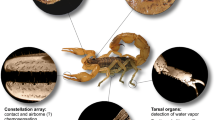Abstract.
Movements of wood mice (Apodemus sylvaticus) were recorded in the field in natural (non-deprived) and in vision- or olfaction-deprived conditions. Both visually and olfactorily deprived animals were able to efficiently orient themselves within their home ranges. There were no, or only nearly, significant differences between the movement characteristics of non-deprived and deprived animals. Moreover, movements of deprived animals were significantly more concentrated than expected in familiar places, i.e. places previously visited in non-deprived conditions (with respect to the null hypothesis that a deprived animal cannot recognize if it is moving through a familiar place). These results suggest that visually or olfactorily deprived wood mice recognize if the current place is familiar or not, and can move and orient themselves within their home ranges mostly as non-deprived wood mice do.
Similar content being viewed by others
Author information
Authors and Affiliations
Additional information
Electronic Publication
Rights and permissions
About this article
Cite this article
Benhamou, S. Orientation and movement patterns of the wood mouse (Apodemus sylvaticus) in its home range are not altered by olfactory or visual deprivation. J Comp Physiol A 187, 243–248 (2001). https://doi.org/10.1007/s003590100195
Accepted:
Issue Date:
DOI: https://doi.org/10.1007/s003590100195




